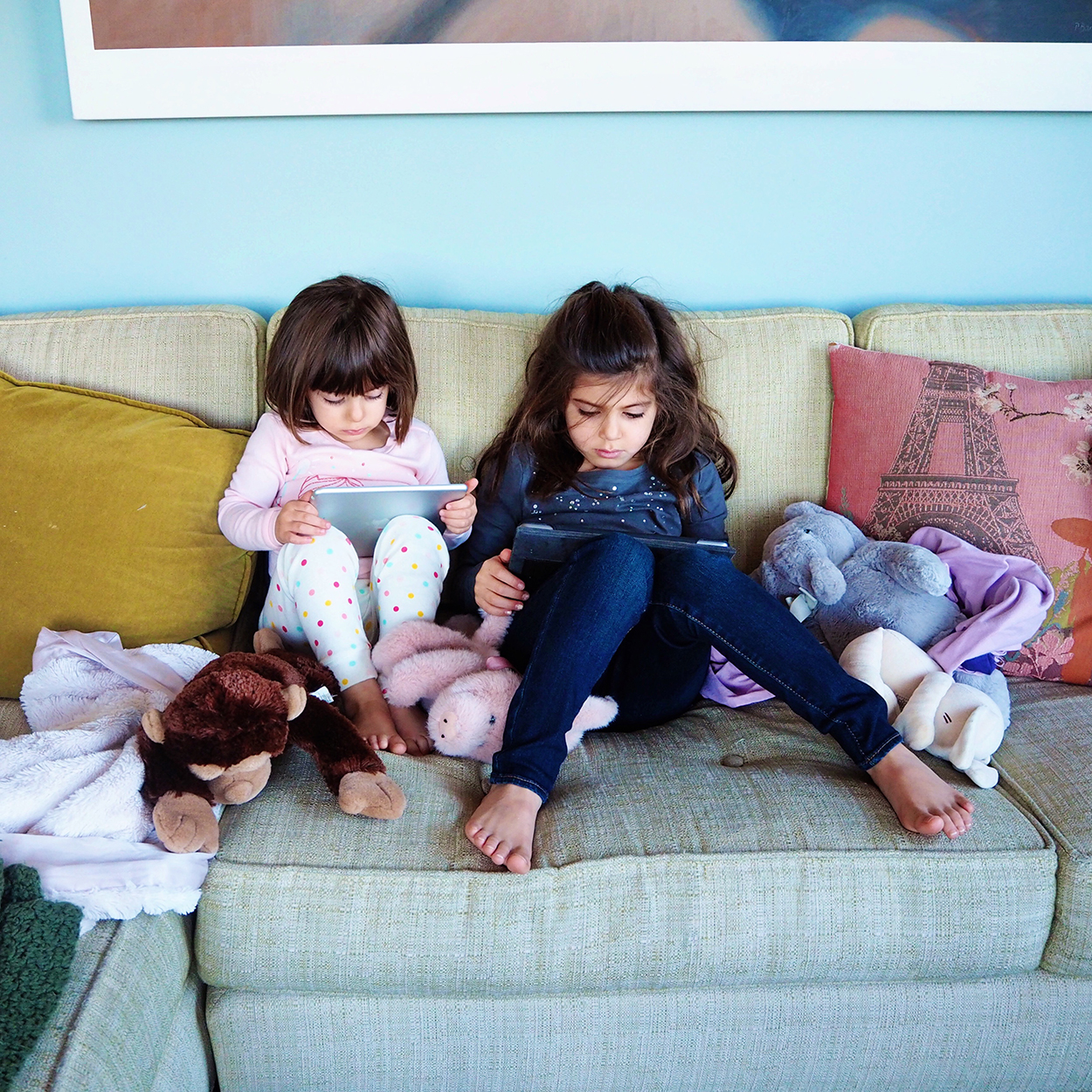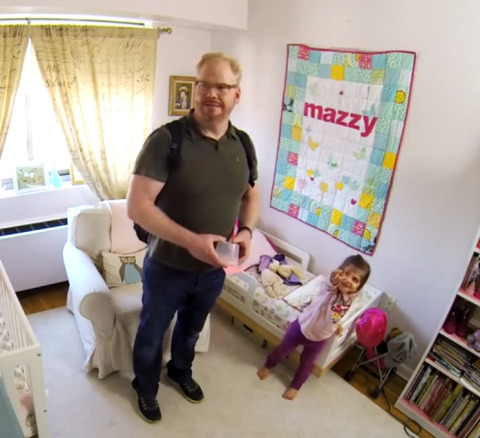“Conversations with your Kids” is a series in partnership with Responsibility.org, an organization that encourages parents to establish open lines of communication with their children, particularly around the issues of peer pressure and underage drinking. For this week’s post, Devorah Heitner, Ph.D., provides expert tips on how to navigate the conversation around tech and internet safety.
There are positives and negatives for being a mom like myself who is so heavily invested in social media and technology. On the one hand, I definitely model behavior that shows I am plugged in quite regularly, although I like to say that I am usually taking pictures and videos while focused on my kids, as opposed to checking email or using it as a distraction to avoid engaging. On another positive note, I feel like knowing about the different apps and having a deeper understanding of social media than most, will be very useful when my kids start using it on their own.
But I obviously don’t want Mazzy and Harlow to feel like life begins and ends with their iPads.
Devorah Heitner is the founder and director of Raising Digital Natives, a resource for parents and schools seeking advice on how to help children thrive in a world of digital connectedness. Her book, Screenwise: Helping Kids Thrive (and Survive) in Their Digital World, helps readers become tech-positive parents and educators. As my kids get older, I have become increasingly more conscious of what I post about them and I think Devorah makes a good point that asking their permission (something I have been doing a lot with Mazzy lately) is a good way to establish appropriate internet behavior for when they begin to post pics themselves. She gives her tips below.
11 Tips to Teach Your Kids How to Have a Healthy Relationship with Tech
1. Set respectful rules of engagement. Sharing pictures of your tweens or teens takes control away from them. Same with updates about them in your Facebook, Instagram or Twitter feed. Luckily, there’s a simple rule: Ask their permission! Asking your kids before sharing teaches them that you respect them and their privacy. What’s more, this practice brings up the opportunity to discuss boundaries with your children. Set up some rules. Every single member of the family should have a stated preference about posting or sharing images of other family members. Same goes for older siblings— they should not share images or video of younger siblings. Parents have told me that implementing this simple practice of asking before sharing a picture brought an immediate and measurable increase in family trust!
2. Be present (you too!) Be the parent that has unplugged breakfasts and dinners with your family. That means you, too! Your boss can wait. Many of us are checking email hundreds of times a day. Productivity experts and family experts agree—this doesn’t help your productivity OR your relationships. If you text at dinner, don’t expect your tween or teen to leave their phone somewhere else or turn it off. Model focused conversation, eye-contact, and turning off all devices during family time, otherwise it will be very difficult to get your teen or tween to unplug and be present…ever.
3. Stay digitally informed. You need to know what’s out there. You don’t need to get a PhD in Snapchat, but you should have some idea how kids use it and the role it plays (or will play) in their lives. On the social media front, in addition to many online sources, ask young adults in your life: a just-out-of-college colleague, or college-aged niece or nephew can give you a tutorial on Instagram, House Party or whatever the latest, greatest app might be. If you connect with your teen or tween on the app, play nice and don’t embarrass them in front of their friends (by commenting on their pictures, etc.) Most teens would prefer to keep some distance from their parents on social media.
4. Mentor more than you monitor. If you want to know what your kids are doing on their devices, start by talking with them. Have empathy for their experiences, and ask them what would make their texting and social media encounters better, easier or less stressful. If you are tempted to use spy software to see what they are doing, consider having them give you a tour of their accounts as an alternative. Before they download a new social application such as Instagram, have them show you how other kids are using the app, and ask them to show you both positive and negative examples. It is a great way to hear them explain their own discernment process. If you feel you must spy, disclose that you have access to their communication and explain why. Be sure you are being honest with yourself about what you are looking for before you start reading their messages, etc.
5. Ditch the distractions. Doing homework in the presence of distractions is no easy task. There are endless distractions, right there on the very screen your child is using to work on her assignments. Many parents tell me that wifi makes completing homework take longer than it should. So, how much of your child’s homework can be done unplugged? Can they turn off the device’s wifi —or even the home wifi—and still get their work done? How much connectivity is truly required? Teens may want to break study hours up into “unplugged” and “plugged” study hall. Unplugged homework means no smartphone in hand—put it away until “plugged”time. Homework will get completed much faster. You can model this for your kids when you need to block distractions to complete important work. Some teens may like using productivity apps like Anti-Social to limit their social media time or Freedom to temporarily shut off alerts and reminders during homework time. You want to see them take responsibility for managing distractions before college.
6. Don’t Text and drive: Ever. Ever. If your kids have seen you do it, you have to talk about it. If you need to see something terrifying, watch Dr. Strange with your kids (be ready for a traumatic car crash.) Be clear with your kids that this is non-negotiable.
7. Conflict with Friends. It is especially important that when kids have a conflict, they know that sometimes they need to work it out face to face. A sense of urgency can take over when trying to resolve a dispute. It can escalate quickly. As a general rule of thumb, never say anything to someone online that you wouldn’t say in real life. To make matters worse, conflicts online can be easily shared and it’s important for your kids to understand that a nasty exchange as part of a group text or a rude comment on someone else’s Instagram picture can quickly become a spectator sport with much greater repercussions than if resolved privately. Ask your kids to think of examples of when it is better to exercise restraint, be patient, and resolve the issue in an in-person meeting. The phone can work too, but it’s extremely difficult to successfully resolve an argument via text message. Suggest to your students that they can avoid escalating a conflict with a simple message such as, “Texting might not be the best way to discuss this—can we talk this over F2F?”
8. FOMO: You can’t be everywhere… and a lot of times you aren’t invited. Remember all the times you heard about a party the next day and felt left out? Now imagine you can see pics and video of the event while you are home alone. This can be devastating at a time when popularity and social standing is everything. This 15 year old says “Snapchat makes me feel awful about myself.” Read it with your kids. Talk with them openly about times you felt left out, how it happens to everybody and how you can help yourself feel better by appreciating the friends and family around you and not always wondering what better things are going on. Work on modeling being present in the moment.
9. Set up interaction boundaries! In elementary school, “friends” online should only be people parents know. Kids should stay away from strangers just like they would in real life and parents should be careful to make sure their kid’s games and apps aren’t open to a public server. For instance, YouTube Kids does not have access to comment sections like regular YouTube. By middle school, kids may be ready to game with strangers, but they should be ready to end the game and find another server if things get creepy. If your kids game on a public server, walk them through strategies for what to do if they are asked inappropriate questions, or if anyone wants to find out how to contact them. Make sure kids know not to give out their phone numbers or addresses to people they meet online, even though they might feel like they’ve established trust. No middle schooler or elementary school kid should have social media followers on apps like musical.ly that they don’t know!
10. What about Sexting? First, no one should coerce or pressure you into sharing images of yourself. It is important to emphasize this to both boys and girls and be clear that under no circumstances is it “cool” for boys to collect images of girls (for example). As much as we don’t like to think about it, it’s worth having a discussion rather than lecturing our kids about sexting. Help kids understand that pictures can be taken out of context, and ask them to think about how their future self might feel about an image. If kids receive an inappropriate picture, they need to know they should not share it further. Even if the photo is being passed all over school, they should recognize this as non-consensual sharing and not participate. Curiosity and interest in sex and sexual feelings are normal parts of adolescent development. In other words, creating and sharing a picture doesn’t mean there is something terribly wrong with your child, but we don’t live in a society where this is a safe way to explore sexuality. If you find out that your child has shared an image of him or herself or has received an inappropriate image of a peer, try to learn more about the context before you panic. If the context was coercive, that is a problem of significant magnitude. If the context was consensual at one time, but is no longer (i.e., an ex-partner circulates an image), that is also a concerning scenario. If the images were consensually exchanged and your child does not feel harmed or embarrassed, then that is the best-case scenario in what is admittedly challenging terrain. “So You Got Naked Online” has great advice for young people who find themselves in this situation.
11. When to get help: Teens and tweens are often proud of their online self-sufficiency, but they need to know when to get help. If a friend is posting about self-harm or suicidal thoughts, they need to get an adult involved. If someone in an online community makes threats or is harassing someone else, help is needed. While we want kids to learn how to solve ordinary conflicts themselves, online harassment or threats (even if it is a friend in crisis) is not the time to try to be self-sufficient. You can point out that you would seek help from a professional in these kinds of situations.
If anyone has any more questions about internet safety that were not addressed here, please ask them in the comments. Devorah will try to answer as many as she can!
To find out more about Responsibility.Org, click here.


























It’s such a touchy subject for both the t(w)eens, parents and community. I feel like it makes such a vulnerable population at higher risk. Thanks for tackling the subject. I’m sure it’ll evolve over time as teens and technology become smarter!
You’re absolutely right! Parents should lead by example. So, parents, put down your phone, switch off the TV and focus on your child. Show them that they are a priority in your life.
Agreed with the above content ! Parents are the responsible for kids health and every activity.
My kids are 8 now. I let them have unlimited iPad till they went to preschool. During the school week, they get 2.5 hrs. Friday night is unlimited and Saturday and Sunday are 3 hours. Us Gen X kids had unlimited Tv and Atari. It not much difference except more bad for the eyes and hands. It’s a great tool to bargain with my kids. If I take away iPads or computers they will behave and try their best. We have friends who are minimalist and let your kids have one hour a week of iPad time. That’s insane.